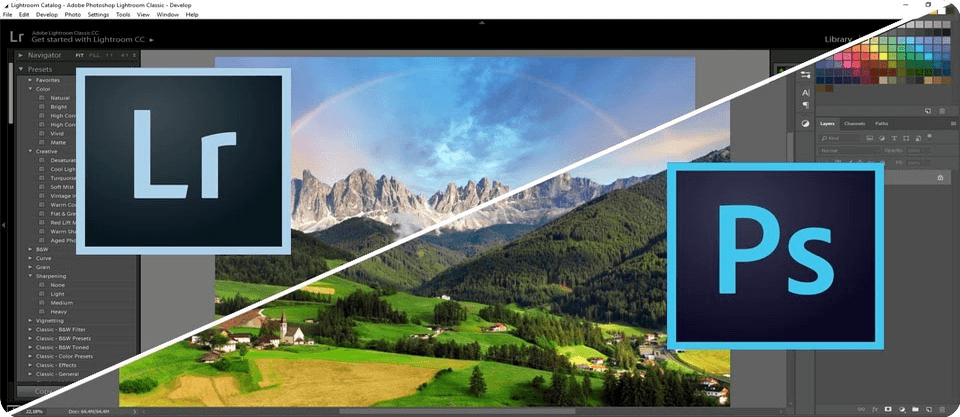
Adobe Lightroom vs Photoshop - Key differences you need to know
Photoshop is synonymous with photo and image editing, so much so that it has become part of our vernacular when it comes to anything that appears to have been edited in some way.
However, for people who are considering using the program there can be a lot of confusion over whether or not Photoshop is the correct program, particularly when it comes to photography. This decision can be made even more complicated by the fact that Adobe’s photography bundle comes with Lightroom and Photoshop together. So, what is the difference between them and what should you be using?
First off let’s explore what each program does.
We are going to look at:
The key differences between Lightroom and Photoshop
What is Lightroom?
Lightroom is primarily known as a Digital Assets Management (DAM) program. What this means in plain English is that it’s used to easily organise your files (in this case photos) into folders and move them around your drives. However, that is only a fraction of what the program is capable of. Lightroom is designed for photography. It is used to upload, sort, manage, edit and output photographs. It is capable of doing this for hundreds of photos at once, should you require that functionality. For example, if you are a wedding photographer you can upload an entire day’s shoot, quickly choose your best photos, and apply general edits across all of them to speed up the editing process. This is not to say that Lightroom is only designed with professional photographers in mind. For day-to-day editing, it is perhaps the top photography program out there, for enthusiasts and pros alike.
What is Photoshop?
Photoshop is an image editing program. It is used to edit and create all types of image files. It is used by a wide range of creative industries, for editing photographs, compositing digital art, animating, and graphic design. It is a broad program; Adobe Photoshop is the predominant photo editing and manipulation software on the market. Its uses range from the full-featured editing of large batches of photos to creating intricate digital paintings and drawings that mimic those done by hand. Photoshop’s naming scheme was initially based on version numbers. However, in October 2002, following the introduction of Creative Suite branding, each new version of Photoshop was designated with “CS” plus a number. In June 2013, with the introduction of Creative Cloud branding, Photoshop’s licensing scheme was changed to that of software as a service or subscription rental model and the “CS” additions were replaced with “CC”. Photoshop files have the default file extension as .PSD, which stands for “Photoshop Document” but can save images as all standard formats. Photoshop is extremely creative and can be used in all industries, your imagination is only limited to your creativity.
When to use Lightroom
If you are a photographer you are going to be using Lightroom about 90% of the time, if not more. This is simply because all the tools that you need to edit photos, whether it is one or many, are found in Lightroom. Many of these tools have been taken directly from Photoshop, particularly the RAW processing. There are some limitations we will look at a little later but with Lightroom you have a huge variety of different editing tools available to you. What this means is that you can not only edit things like your exposure and sharpening or other basic edits, but you can also develop your own style through the use of colour grading and effects, and then save these so that they can be applied to future projects. Again, to use the example of a wedding photographer, this means that you can save yourself a lot of time by applying these edits and keep consistent with a look that is unique to you.
The advantages of Lightroom
There are many reasons to use lightroom over photoshop and other photography programs.
- Lightroom is an easy program to pick up and start using – its interface is intuitive and easy to navigate, as each option such as organisation and editing are broken into individual modules.
- It is the safest way to work on your photos – Lightroom uses a catalogue system. This can be a little complicated to understand but simply it means that when you are editing in Lightroom, you are not directly altering your file, meaning that any changes can be easily undone and are not destructive to the file.
- The program has bulk/batch processing – as mentioned before Lightroom can handle multiple files for editing all at once. This means you can apply edits to your photos, even at the time of import, to speed up your workflow. Every photographer knows that editing can be a time-consuming process, so if you can reduce the amount of editing time, you have more time for taking photos!
- It is available as an app – you can get Lightroom on your phone or tablet, although it is a little more limited than the desktop version. However, the app can be synced via the cloud for different devices, meaning that you can edit on the go and have the files updated on other devices at the same time.
- Lightroom features a RAW editor – photographers who take their pictures in the recommended RAW format can upload their collections straight to Lightroom and begin working in the same layout as one would find when editing lossy files such as JPEGs or PNGs.
- There is enhanced masking – selective editing tools such as the adjustment brush and radial filters now utilise colour and luminance ranges for more refined masking. Machine-learning now powers Lightroom for automatic subject or sky selection with the press of a single button. There’s also greater compatibility with new cameras and lenses.
When to use Photoshop
This question is a little harder to answer as Photoshop is a broad program that spans many creative disciplines. If you are working in design or other related fields you will be using the program extensively, but usually not exclusively. Photoshop has the ability to use vectors as well as pixels meaning that images, illustrations and animations can be made from the ground up. For photographers the usage of photoshop is quite different, unless of course you are creating logos for your business. Photoshop does have camera RAW to edit photos and this is identical to what is found in Lightroom. However, it does not accommodate batch processing in the same manner as Lightroom. Generally, photographers will use Photoshop for cosmetic retouching, which there are far more options for compared to Lightroom, and for image compositing. Image compositing is when two or more photos or images are merged together to create a final new image. This is frequently done in advertising and for artistic purposes. Of course, you can perform all the other edits to your photos in Photoshop as found in Lightroom but the key difference is that Photoshop has a steep learning curve and the UI can be very daunting for new users.
The advantages of Photoshop
- Photoshop has unlimited creative potential – if you can think it and have the skill, you can create it in Photoshop.
- The program has extensive tools – there are so many tools to use in Photoshop and these tools can be altered for specific purposes. This means that no matter the project you are working on, you should be able to find the exact tool that you need.
- There is layer editing – the key to Photoshop is in its layer editing. Unlike Lightroom, Photoshop allows layers of edits that interact and affect different parts of the image, giving users much more control over the look of the image. This is particularly important in the creation of image composites.
- Cosmetic retouching and object removal – while Lightroom has some healing and cloning tools, it is a fraction of the tools that are available on Photoshop if you are working on cosmetic photos or if you need to remove objects from images.
- Available on all platforms – Adobe Photoshop is available on almost all platforms including Windows, macOS, Android, iOS, iPad OS, etc. So, no matter which operating system you are using, you can install Photoshop in any one of them. The interface and available tools may vary based on the operating system you are using. For example, the iOS version or the Android version of Photoshop may not have all the tools available in the PC or Mac OS versions.
- Supports almost all image formats – You can edit almost all the image formats using Photoshop. If any format is not supported yet, there are Photoshop plugins available that will implement the compatibility. You can edit or convert any known image formats using Adobe Photoshop.
- It is the industry standard – Photoshop is a very valuable program to master. It is so broad that it is in demand in various industries, so adding it to your resume can be a boost to your career.
Which should you use?
Again, a complicated question to answer. If you are a designer, you will find little use in Lightroom and Photoshop is the way to go. If you are a photographer Lightroom is the better choice as you will use it most of the time but ideally you will use both Lightroom and Photoshop together but may use Photoshop less frequently.
Do you want to learn how to use Photoshop or Lightroom? Join Upskillist today and take your skills to the next level.



